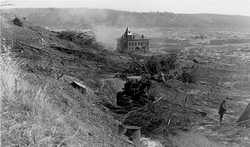History
Incorporated in 1816 from portions of Greenwich and Belchertown. It was named in honor of one of its early settlers, Robert Field. [3] General Joseph Hooker, Union general during the American Civil War, was once a resident, and his grandfather was once a town leader. It was centered at the junction of the east and west branches of the Swift River, and the Athol Branch of the Boston and Albany Railroad ran through the town. The town bordered six other towns—Belchertown, Pelham, Greenwich, Prescott, Ware, and Hardwick.
Enfield was disincorporated on April 28, 1938, and portions of the town were annexed to the adjacent towns of Belchertown, New Salem, Pelham, and Ware. (Not all of the former town is now in Hampshire County: the portion ceded to New Salem is now in Franklin County.) At the town's final ball, the band played Auld Lang Syne. When the song ended, the town became a part of Belchertown.
The headquarters of the Metropolitan District Commission during the construction of the Quabbin Reservoir was located in the former town hall and was the last building razed in the Swift River Valley, in 1940. The majority of the town center now lies submerged beneath the reservoir, although the Quabbin Observatory and Enfield Lookout, located on scenic Quabbin Hill, as well as the main entrance and headquarters of Quabbin State Park, a popular tourist destination with an emphasis on state history and nature, are all within the former town's limits.
Enfield House, an on-campus living facility at Hampshire College in Amherst, Massachusetts, is named after the former town.
This page is based on this
Wikipedia article Text is available under the
CC BY-SA 4.0 license; additional terms may apply.
Images, videos and audio are available under their respective licenses.





